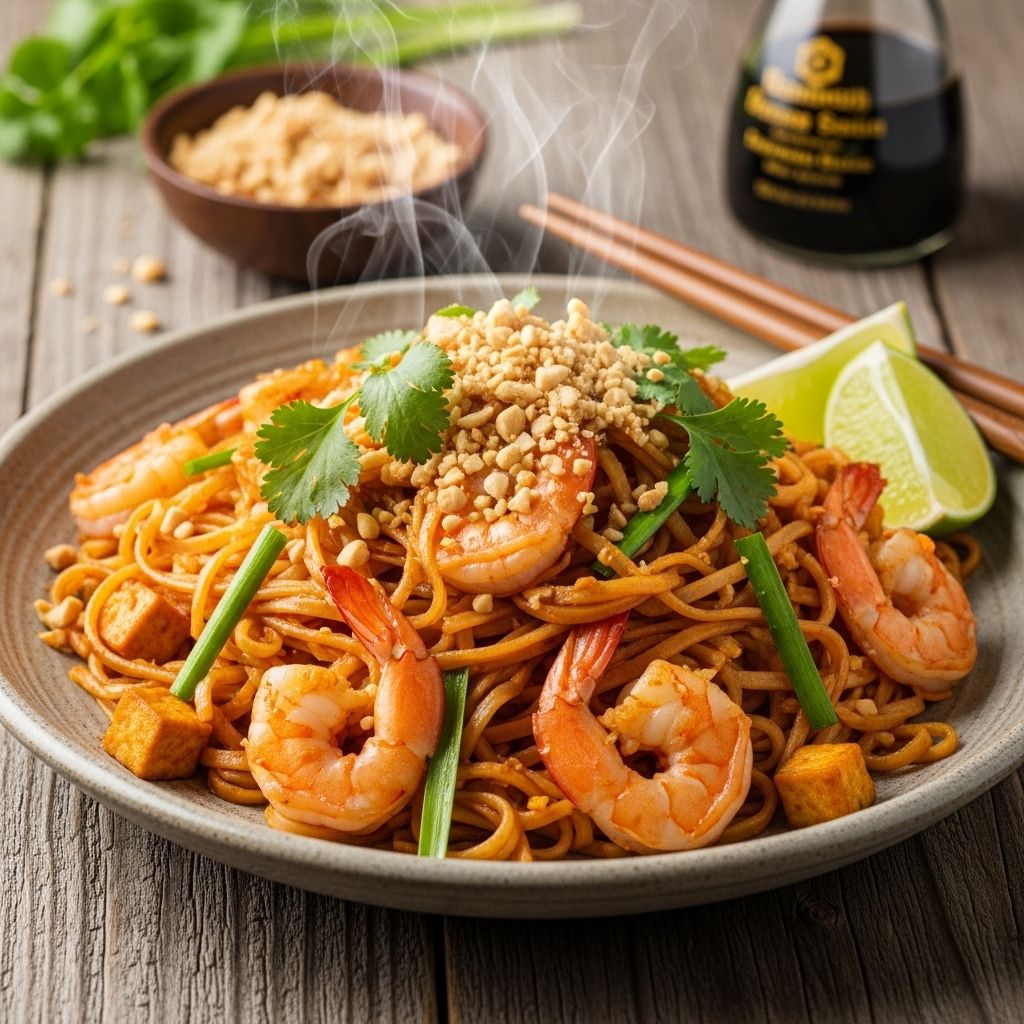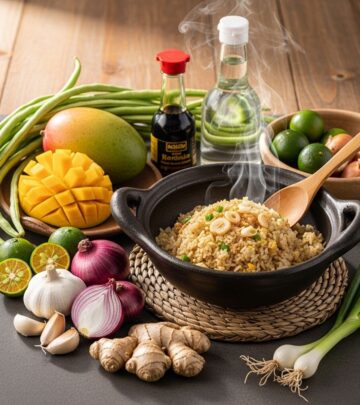Pad Thai Recipe: 7 Authentic Steps For Homemade Flavor
Discover how to make authentic Pad Thai at home with easy-to-follow steps, helpful tips, and customizable options for a memorable Thai meal.

Image: HearthJunction Design Team
Classic Pad Thai: The Ultimate Guide
Pad Thai is one of Thailand’s most well-known and beloved street foods, featuring rice noodles stir-fried with a signature sweet-sour-salty sauce, protein, eggs, vegetables, and crunchy peanuts. Whether you’re a fan of the restaurant version or looking to master homemade Thai cuisine, this comprehensive guide will lead you through every step to create a delicious, customizable Pad Thai in your own kitchen.
What is Pad Thai?
Pad Thai is a stir-fried noodle dish that originated in Thailand and quickly became a global favorite. Its signature combination of chewy rice noodles, tender chicken or shrimp, crunchy vegetables, and a flavorful sauce creates a balance of sweet, sour, and salty flavors. Pad Thai is often garnished with lime wedges, chopped peanuts, and fresh herbs, making each bite unique and satisfying.
Pad Thai Ingredients
Each ingredient in Pad Thai adds to its distinctive flavor and texture profile. Here’s what you’ll need to prepare the classic version:
- Rice Noodles: Flat rice noodles, about 1/4 inch wide, are the foundation of Pad Thai. Dried noodles are soaked before cooking.
- Protein: Traditional Pad Thai uses shrimp, chicken, or a combination. Tofu is a popular vegetarian substitute.
- Eggs: Scrambled into the noodles for richness and body.
- Vegetables: Usually bean sprouts and green onions. Additional options include carrots or bell pepper for color and crunch.
- Pad Thai Sauce: A blend of fish sauce, tamarind paste, vinegar, sugar, and optional chili creates the signature tangy-sweet flavor.
- Peanuts: Chopped and sprinkled on top for crunch and nutty flavor.
- Lime Wedges: Added at the end for a fresh, zesty finish.
Ingredient Table
| Ingredient | Quantity |
|---|---|
| Dried rice noodles | 8 ounces (about 225g) |
| Chicken breast (or shrimp) | 8 ounces, thinly sliced or peeled |
| Eggs | 2 large |
| Bean sprouts | 2 cups (fresh) |
| Green onions | 4, sliced |
| Fish sauce | 3 tablespoons |
| Tamarind paste | 2 tablespoons |
| White vinegar | 2 tablespoons |
| Sugar | 3 tablespoons |
| Red pepper flakes | 1/2–1 teaspoon (to taste) |
| Chopped peanuts | 1/2 cup |
| Lime wedges | For serving |
| Oil (vegetable or canola) | 2–3 tablespoons |
How to Make Pad Thai: Step-By-Step Instructions
- Soak the Rice Noodles
Place the dried rice noodles in a large bowl. Cover them with warm water and let soak for about 30 minutes, or until they are tender but not mushy. Drain well and set aside.
- Prepare the Pad Thai Sauce
Mix the fish sauce, tamarind paste, vinegar, sugar, and red pepper flakes in a small bowl. Adjust sweetness, sourness, or spiciness to taste.
- Cook the Protein
Heat 1 tablespoon oil in a large skillet or wok over medium-high heat. Add the chicken or shrimp and stir-fry until just cooked through, about 2–3 minutes. Remove from the pan and set aside.
- Scramble the Eggs
Add another tablespoon of oil. Crack the eggs directly into the pan and scramble them until just set. Push to one side of the pan.
- Stir-Fry the Noodles
Add drained noodles to the pan. Pour in the prepared sauce and toss to combine thoroughly. Stir-fry for 2–3 minutes, letting the noodles absorb the sauce.
- Combine and Finish
Return the cooked chicken or shrimp to the pan. Add the bean sprouts and half of the green onions. Toss everything together for 1–2 minutes until heated through and well mixed.
- Garnish and Serve
Transfer Pad Thai to serving plates. Sprinkle generously with chopped peanuts and remaining green onions. Garnish with lime wedges. Serve hot.
Tips for Perfect Pad Thai
- Use a Large Wok or Skillet: This allows the noodles and ingredients room to fry properly without steaming.
- Prep Ingredients in Advance: Pad Thai cooks quickly, so have everything measured and ready.
- Don’t Overcook the Noodles: Slightly under-soak before stir-frying to prevent mushiness.
- Adjust the Sauce: Balance fish sauce (salty), tamarind (sour), sugar (sweet), and chili (spicy) to your liking.
- Customize Your Protein: Substitute tofu for vegetarians, or mix pork, beef, or even extra veggies.
Pad Thai Variations and Substitutions
- Vegetarian Pad Thai: Omit fish sauce or use a vegetarian alternative. Replace chicken/shrimp with extra tofu and more vegetables.
- Gluten-Free Pad Thai: Use gluten-free tamari in place of soy sauce if it’s included, and ensure all other sauces are gluten-free.
- Extra Spicy: Add more chili flakes or a spoonful of chili garlic sauce for a fiery kick.
- Nut-Free Option: Omit peanuts and substitute with toasted sesame seeds for crunch.
Serving Suggestions
Pad Thai is best enjoyed fresh from the pan with tasty garnishes and sides. Serve with:
- Extra lime wedges for squeezing over each serving
- Additional chili flakes or chili sauce on the side
- Fresh cilantro leaves for herbal freshness
- Sliced cucumber or a side salad to balance the flavors
Frequently Asked Questions (FAQs)
Q: Can I use store-bought Pad Thai sauce?
A: Yes, store-bought Pad Thai sauce is convenient, but homemade sauce provides a fresher, customizable flavor. If using store-bought, taste and adjust seasoning as needed.
Q: What makes Pad Thai sauce tangy?
A: Tamarind paste and vinegar provide the tangy element, balanced by sugar and fish sauce for authentic flavor.
Q: How do I prevent my noodles from sticking?
A: Be sure to soak but not over-soak the noodles. Stir constantly during cooking and add a drizzle of oil if needed. Using a large pan helps avoid overcrowding and sticking.
Q: Is Pad Thai healthy?
A: Pad Thai can be a balanced meal when made at home, especially if you include plenty of vegetables and use lean protein. Customize the amount of sugar and oil to suit your dietary needs.
Q: Can Pad Thai be made ahead?
A: Pad Thai tastes best fresh, but leftovers can be refrigerated for up to 2 days. Reheat in a skillet over medium heat with a splash of water to loosen the noodles.
Expert Tips for the Best Homemade Pad Thai
- Use Fresh Ingredients: Fresh bean sprouts, green onions, and lime make a noticeable difference.
- High Heat Cooking: Use the highest heat possible and work quickly to achieve the signature wok “char” or smokiness.
- Balance Is Key: Adjust the flavor profile to your taste by tweaking sauce ingredients before adding to the noodles.
- Serve Immediately: Pad Thai is best eaten hot, ensuring the noodles stay tender and the toppings remain crunchy.
Storing and Reheating Pad Thai
Leftover Pad Thai can be stored in an airtight container in the refrigerator for up to 2 days. For best results:
- Reheat in a skillet or wok over medium heat.
- Add a splash of water or extra sauce to help loosen up the noodles and restore the texture.
- Avoid microwaving for long periods, as it can make the noodles gummy.
Nutritional Information
Pad Thai is rich in carbohydrates and protein from the noodles and chicken or shrimp. Calories and nutritional values vary based on portion size and ingredient amounts. For a lighter version, use less oil and sugar and add extra vegetables or tofu.
Origins and History of Pad Thai
Pad Thai emerged in Thailand in the mid-20th century and was popularized as a way to promote Thai nationalism and rice noodle consumption. Its blend of local ingredients and influences from neighboring cuisines made it a symbol of Thai culture and innovation. Today, it is celebrated worldwide as an essential part of Thai culinary tradition.
Conclusion
Making authentic Pad Thai at home is straightforward and rewarding. By understanding the importance of each ingredient and following step-by-step instructions, you’ll be able to enjoy Thailand’s favorite noodle dish any time you crave it. Experiment with your favorite proteins, adjust the sauce to your liking, and don’t forget the finishing touches that make Pad Thai so special!
References
Read full bio of Shinta












